格拉斯哥大学-运营管理教材
运营管理英文原书13版

运营管理英文原书13版简介《运营管理》是一本经典的运营管理教材,其第13版是该书的最新版本。
本书是由作者 Jay Heizer 和 Barry Render 合作编写的,旨在为读者提供运营管理领域的最新理论和实践知识。
内容概述本书共分为五个部分,每个部分聚焦于不同的运营管理主题。
以下是各部分的简要介绍:第一部分:运营管理介绍本部分旨在介绍运营管理的基本概念和原则。
读者将了解到运营管理的定义、历史发展以及其在不同组织中的作用和重要性。
第二部分:战略规划与运营决策这部分介绍了运营管理中的战略规划和决策过程。
读者将学习到如何制定和执行运营战略、如何进行产品和服务设计、如何管理供应链以及如何做出运营决策。
第三部分:产品与服务管理本部分聚焦于产品和服务管理的关键问题。
读者将了解到新产品开发的过程、如何进行质量管理、如何管理服务操作以及如何进行项目管理。
第四部分:供应链管理这一部分将介绍供应链管理的概念和实践。
读者将学习到如何管理供应链中的物流、运输和库存,以及如何协调供应链中的各个环节。
第五部分:运营控制和改进最后一部分关注的是运营控制和改进。
读者将学习到如何进行质量控制、如何进行生产计划与控制、如何进行预测和库存管理,以及如何使用运营管理信息系统。
适用对象这本书适合对运营管理感兴趣的学生、研究者和从业人员阅读。
无论您是学生在学习运营管理的理论知识,还是从业人员需要应用运营管理原理和技术来改善组织运作,本书都能给您提供必要的指导。
为何选择该书为什么选择《运营管理英文原书13版》?以下是一些优点:1.全面而深入的内容:该书囊括了运营管理领域的各个方面,让读者全面了解运营管理的理论和实践。
2.更新的版本:该书的第13版是最新的版本,内容经过了核心概念和实践的更新,以反映运营管理领域的最新发展。
3.动态的案例研究:书中包含了丰富的案例研究,这些案例都是实际运营管理中的真实问题,让读者能够理解和应用所学的知识。
4.高质量的作者团队:本书的作者 Jay Heizer 和 Barry Render 都是运营管理领域的专家,他们的经验和知识为本书提供了可靠的理论基础。
运营管理基础(原书第4版)PPT-Chap011s

–Whether the arrival stays in line or leaves
• Balking or reneging
6
Arrival Characteristics in Queues
Exhibit S11.2
7
Physical Features of Lines
• Introduce the major characteristics that exist in waiting lines and describe how they can impact a customer’s waiting time.
• Identify the various constraints and/or conditions that waiting line theory and its associated equations require for the results to be valid.
Exhibit S11 .5
13
Equations for Solving Six
Model Problems
Exhibit S11.6a
14
Equations for Solving Six
Model Problems (cont’d)
Exhibit S11.6b
15
Notations for
the system
3
Framework for Viewing Waiting Line Structures
Exhibit S11.1e
• Finite Population
–Limited size of the customer pool
运营管理原版书14版
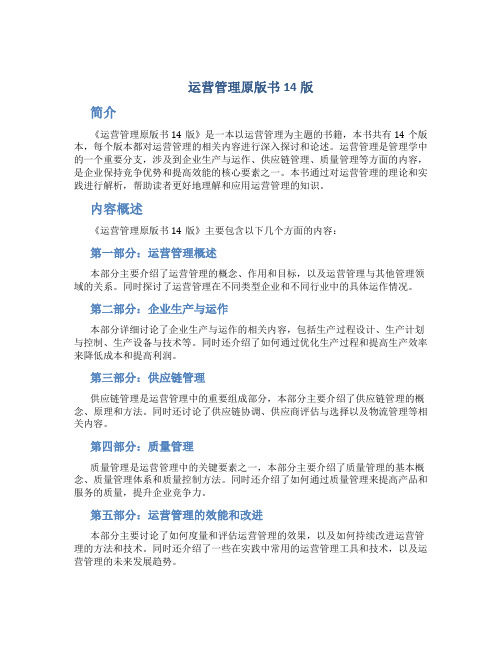
运营管理原版书14版简介《运营管理原版书14版》是一本以运营管理为主题的书籍,本书共有14个版本,每个版本都对运营管理的相关内容进行深入探讨和论述。
运营管理是管理学中的一个重要分支,涉及到企业生产与运作、供应链管理、质量管理等方面的内容,是企业保持竞争优势和提高效能的核心要素之一。
本书通过对运营管理的理论和实践进行解析,帮助读者更好地理解和应用运营管理的知识。
内容概述《运营管理原版书14版》主要包含以下几个方面的内容:第一部分:运营管理概述本部分主要介绍了运营管理的概念、作用和目标,以及运营管理与其他管理领域的关系。
同时探讨了运营管理在不同类型企业和不同行业中的具体运作情况。
第二部分:企业生产与运作本部分详细讨论了企业生产与运作的相关内容,包括生产过程设计、生产计划与控制、生产设备与技术等。
同时还介绍了如何通过优化生产过程和提高生产效率来降低成本和提高利润。
第三部分:供应链管理供应链管理是运营管理中的重要组成部分,本部分主要介绍了供应链管理的概念、原理和方法。
同时还讨论了供应链协调、供应商评估与选择以及物流管理等相关内容。
第四部分:质量管理质量管理是运营管理中的关键要素之一,本部分主要介绍了质量管理的基本概念、质量管理体系和质量控制方法。
同时还介绍了如何通过质量管理来提高产品和服务的质量,提升企业竞争力。
第五部分:运营管理的效能和改进本部分主要讨论了如何度量和评估运营管理的效果,以及如何持续改进运营管理的方法和技术。
同时还介绍了一些在实践中常用的运营管理工具和技术,以及运营管理的未来发展趋势。
适合读者群体《运营管理原版书14版》适合以下几类读者:•运营管理专业的学生和研究人员,可以用作教材和参考书;•从事运营管理工作的企业管理者和从业人员,可以用作工作参考;•对运营管理感兴趣的读者,可以用作了解运营管理领域知识的参考书。
总结运营管理是企业保持竞争优势和提高效能的重要领域,对企业的发展起着至关重要的作用。
运营管理类书籍
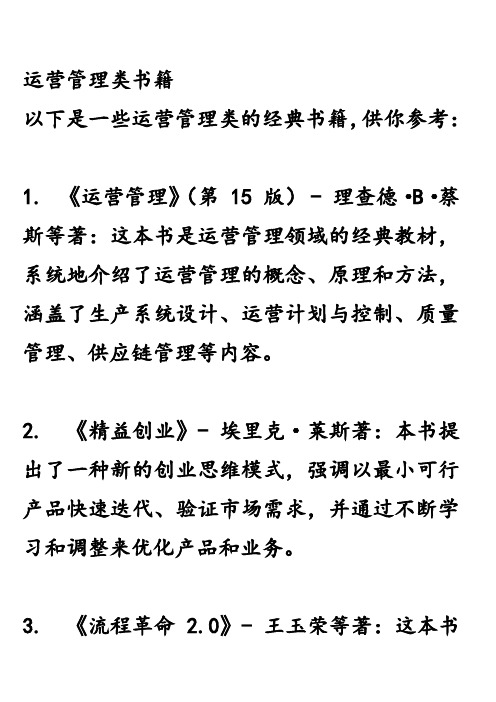
运营管理类书籍
以下是一些运营管理类的经典书籍,供你参考:
1. 《运营管理》(第 15 版) - 理查德·B·蔡斯等著:这本书是运营管理领域的经典教材,系统地介绍了运营管理的概念、原理和方法,涵盖了生产系统设计、运营计划与控制、质量管理、供应链管理等内容。
2. 《精益创业》- 埃里克·莱斯著:本书提出了一种新的创业思维模式,强调以最小可行产品快速迭代、验证市场需求,并通过不断学习和调整来优化产品和业务。
3. 《流程革命 2.0》- 王玉荣等著:这本书
以流程为核心,探讨了企业如何通过流程优化和数字化转型来提高运营效率、降低成本,并实现持续改进。
4. 《第五项修炼:学习型组织的艺术与实践》- 彼得·圣吉著:本书强调了组织学习的重要性,介绍了创建学习型组织的五项修炼,包括自我超越、改善心智模式、建立共同愿景、团队学习和系统思考。
5. 《目标》- 艾利·高德拉特等著:这是一本以小说形式讲述生产管理的书籍,通过一个工厂的故事,阐述了如何通过有效的生产管理和目标设定来提高企业效益。
6. 《从 0 到 1:开启商业与未来的秘密》- 彼得·蒂尔著:本书分享了作者关于创业、创新和未来商业发展的思考,强调了从无到有、创造独特价值的重要性。
这些书籍涵盖了运营管理的不同方面,从基础理论到实践应用都有涉及。
选择适合自己需求的书籍进行阅读,可以帮助你深入了解运营管理的核心概念和方法,并应用于实际工作中。
运营管理原书第14版

运营管理原书第14版《运营管理原书第14版》是由作者William J. Stevenson所著的一本经典运营管理教材。
本书的第14版在前一版的基础上进行了更新和改进,旨在为读者提供最新的运营管理理论和实践应用。
一、作者简介William J. Stevenson是运营管理领域的知名学者和作者,他在运营管理方面有着丰富的研究和教学经验。
他曾在多所知名大学任教,并多次荣获运营管理领域的奖项和荣誉。
他在本书中系统地介绍了运营管理的重要概念、理论和实践,并通过案例研究和实际操作指导,帮助读者理解这一领域的核心内容。
二、书籍概要《运营管理原书第14版》全书共分为多个章节,涵盖了运营管理的各个方面。
以下是本书的主要内容概述:1. 运营管理概述第一章介绍了运营管理的基本概念、作用、目标和与其他管理领域的关系。
读者可以了解到运营管理的重要性以及它在企业中的角色和职责。
2. 供应链管理第二章重点介绍了供应链管理的基本原理和技术。
供应链管理是现代企业运营管理的重要组成部分,它涉及到物流、采购、生产和销售等多个环节,读者可以学习到如何优化供应链流程,提高运营效率和客户满意度。
3. 项目管理第三章讲解了项目管理的基本概念和技术。
项目管理是一种规划、组织和控制项目活动的方法,它涉及到项目目标、资源管理、进度控制、沟通协调等方面。
读者可以学习到如何有效地管理项目,实现项目的成功交付。
4. 质量管理第四章介绍了质量管理的原理和方法。
质量管理是提高产品和服务质量的一系列流程和工具,它关注产品质量控制、质量改进和质量保证等方面。
读者可以了解到如何建立和维护良好的质量管理体系,提升企业的竞争力。
5. 运营策略第五章探讨了运营策略的制定和实施。
运营策略是企业运营管理中的重要组成部分,它涉及到市场定位、产品创新、成本控制、品牌管理等方面。
读者可以学习到如何制定与企业战略一致的运营策略,为企业的长期发展提供支持。
6. 运营决策第六章介绍了运营决策的基本原则和方法。
运营管理英文版原书第十一版课程设计

运营管理英文版原书第十一版课程设计课程简介本课程旨在探讨现代运营管理的基本概念、原理和实践。
通过学习本课程,学生将了解运营管理的重要性,理解现代运营管理的基本概念,掌握运营管理的基本原理和方法,了解运营管理在企业中的应用,并学会分析和解决运营管理中遇到的实际问题。
课程目标1.理解运营管理的基本概念和原理;2.掌握运营管理的基本方法和技术;3.了解运营管理在企业中的应用;4.能够分析和解决运营管理中遇到的问题;5.能够在实践中运用所学知识。
课程大纲第一章运营管理基础1.1 运营管理概述 1.2 运营管理的历史和发展 1.3 运营管理的作用和价值1.4 运营管理的基本特征 1.5 运营管理的理论框架第二章作业系统设计2.1 作业系统的定义 2.2 作业系统的基本要素 2.3 作业系统的设计原则 2.4 作业系统的设计方法 2.5 作业系统的评价指标和方法第三章作业流程管理3.1 作业流程管理的定义 3.2 作业流程管理的基本原则 3.3 作业流程管理的方法和技术 3.4 作业流程改进的主要方法 3.5 作业流程管理在企业中的应用第四章库存管理4.1 库存管理的定义 4.2 库存管理的基本原则 4.3 库存管理的方法和技术4.4 库存管理的优化策略 4.5 库存管理在企业中的应用第五章质量管理5.1 质量管理的定义 5.2 质量管理的基本原则 5.3 质量管理的方法和技术5.4 质量管理的工具和技术 5.5 质量管理在企业中的应用第六章供应链管理6.1 供应链管理的定义 6.2 供应链管理的基本原则 6.3 供应链管理的方法和技术 6.4 供应链优化的方法和技术 6.5 供应链管理在企业中的应用第七章项目管理7.1 项目管理的定义 7.2 项目管理的基本原则 7.3 项目管理的方法和技术7.4 项目管理的评价指标和方法 7.5 项目管理在企业中的应用课程教学形式本课程采用讲授和案例分析相结合的教学形式。
十大运营管理经典书籍

十大运营管理经典书籍运营管理是企业管理中关键的一环,不仅涉及到产品开发、供应链管理、市场营销等方面,还需要具备良好的组织和协调能力。
为了提高运营管理的水平,以下是十本经典的运营管理书籍,供大家参考学习。
1. 《运营之光》作者:采铜《运营之光》是一本以经典案例为基础,介绍运营管理的实际操作方法和流程的书籍。
通过作者的亲身经历,读者可以了解到如何在实践中进行运营管理,如何合理分配资源、整合团队和优化流程,从而提高企业的效率和竞争力。
2. 《供应链管理》作者:戴志帆《供应链管理》是一本系统介绍供应链管理理论和实践的书籍。
通过分析实际案例和理论模型,作者深入浅出地介绍了供应链管理的主要要素和关键环节,包括供应商选择、库存管理、物流运输等,对于提高企业的运营效率和降低成本具有重要的参考价值。
3. 《运营管理》作者:杰·海因茨曼《运营管理》是一本综合性的运营管理领域的经典教材。
作者从多个角度论述了运营管理的要点、方法和技巧,包括生产计划、质量管理、供应链管理等。
这本书不仅适合运营管理专业的学生,也适合企业高层管理人员和运营人员的学习和参考。
4. 《战略运营管理》作者:霍尔·霍斯金森《战略运营管理》是一本介绍战略与运营之间关系的经典著作。
作者通过分析各种实际案例,阐述了如何在制定和执行战略时,与运营管理密切结合,从而实现企业目标和优化绩效。
5. 《运营数字化转型》作者:许陆峰《运营数字化转型》是一本专注于运营数字化转型的实践指南。
作者从理论和实践两个角度出发,详细介绍了运营数字化转型的意义、目标和步骤。
通过本书的学习,读者可以了解到如何有效应对数字化转型带来的挑战和机遇,提高企业的运营效率和创新能力。
6. 《精益生产》作者:詹姆斯·P·沃默克《精益生产》是一本介绍精益生产管理的经典著作。
作者通过详细阐述精益生产的主要原则和实施方法,帮助读者了解精益生产的核心概念和改进实践。
运营管理 第6版本科课件04_chapt

Wq
Lq
1
Ws Wq
运营管理
-29-
马风才 博士
排队系统的基本特征
服务系统利用率(ρ)
基本公式:
M
排队长(Lq)和队长(Ls)
Lq
2 ( )
Ls Lq
p(k) ke
k!
等待时间(Wq)和逗留时间(Ws)
Wq
Lq
( )
11
Ws Wq
运营管理
-30-
马风才 博士
排队系统的基本特征 服务系统利用率(ρ)
排队长(Lq)和队长(Ls) 等待时间(Wq)和逗留时间(Ws)
运营管理
-31-
马风才 博士
需要哪些数据——反映服务系统经济性的数据
➢ 与服务能力有关的成本 ✓ 服务人员的工资 ✓ 服务设施(如收款台、售票窗口、交通工具等)的折旧费 ✓ 维修费
效率
实际能力 有效能力
利用率
实际能力 设计能力
运营管理
-2-
马风才 博士
通过运营管理提高实际产能
起 点 设计
能力
有效 能力
实际 能力
第一步
设计 能力
有效 能力
实际 能力
利用率提高,效率有三种情况
第二步
运营管理
设计 能力
有效 能力
实际 能力
利用率和效率均得到提高
-3-
马风才 博士
算例
位于北京市学院路的一家小型中式比萨快餐店每周营业 7天,2班制,每班工作5小时。比萨制作流水线的设计产能 是每小时400个标准中式比萨。根据快餐店配置的设备及人 员,其有效能力是每周25000个标准中式比萨。平均起来, 由于个别员工缺勤,加上设备偶尔出现的故障,这家快餐店 每周只制作20000个标准中式比萨。试计算:(1)这家快餐 店的设计能力;(2)利用率和效率。
学习运营管理有什么书推荐
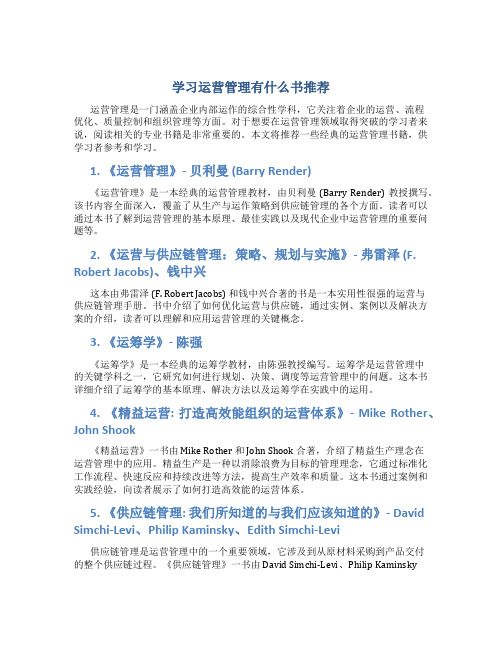
学习运营管理有什么书推荐运营管理是一门涵盖企业内部运作的综合性学科,它关注着企业的运营、流程优化、质量控制和组织管理等方面。
对于想要在运营管理领域取得突破的学习者来说,阅读相关的专业书籍是非常重要的。
本文将推荐一些经典的运营管理书籍,供学习者参考和学习。
1. 《运营管理》- 贝利曼 (Barry Render)《运营管理》是一本经典的运营管理教材,由贝利曼 (Barry Render) 教授撰写。
该书内容全面深入,覆盖了从生产与运作策略到供应链管理的各个方面。
读者可以通过本书了解到运营管理的基本原理、最佳实践以及现代企业中运营管理的重要问题等。
2. 《运营与供应链管理:策略、规划与实施》- 弗雷泽 (F. Robert Jacobs)、钱中兴这本由弗雷泽 (F. Robert Jacobs) 和钱中兴合著的书是一本实用性很强的运营与供应链管理手册。
书中介绍了如何优化运营与供应链,通过实例、案例以及解决方案的介绍,读者可以理解和应用运营管理的关键概念。
3. 《运筹学》- 陈强《运筹学》是一本经典的运筹学教材,由陈强教授编写。
运筹学是运营管理中的关键学科之一,它研究如何进行规划、决策、调度等运营管理中的问题。
这本书详细介绍了运筹学的基本原理、解决方法以及运筹学在实践中的运用。
4. 《精益运营: 打造高效能组织的运营体系》- Mike Rother、John Shook《精益运营》一书由 Mike Rother 和 John Shook 合著,介绍了精益生产理念在运营管理中的应用。
精益生产是一种以消除浪费为目标的管理理念,它通过标准化工作流程、快速反应和持续改进等方法,提高生产效率和质量。
这本书通过案例和实践经验,向读者展示了如何打造高效能的运营体系。
5. 《供应链管理: 我们所知道的与我们应该知道的》- David Simchi-Levi、Philip Kaminsky、Edith Simchi-Levi供应链管理是运营管理中的一个重要领域,它涉及到从原材料采购到产品交付的整个供应链过程。
运营管理原书14版课件
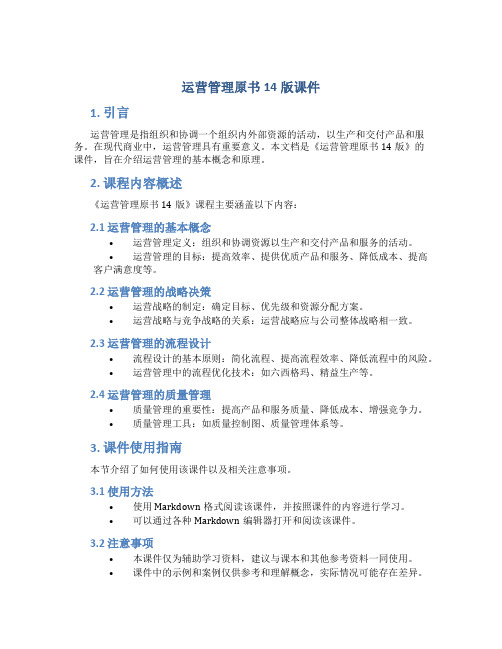
运营管理原书14版课件1. 引言运营管理是指组织和协调一个组织内外部资源的活动,以生产和交付产品和服务。
在现代商业中,运营管理具有重要意义。
本文档是《运营管理原书14版》的课件,旨在介绍运营管理的基本概念和原理。
2. 课程内容概述《运营管理原书14版》课程主要涵盖以下内容:2.1 运营管理的基本概念•运营管理定义:组织和协调资源以生产和交付产品和服务的活动。
•运营管理的目标:提高效率、提供优质产品和服务、降低成本、提高客户满意度等。
2.2 运营管理的战略决策•运营战略的制定:确定目标、优先级和资源分配方案。
•运营战略与竞争战略的关系:运营战略应与公司整体战略相一致。
2.3 运营管理的流程设计•流程设计的基本原则:简化流程、提高流程效率、降低流程中的风险。
•运营管理中的流程优化技术:如六西格玛、精益生产等。
2.4 运营管理的质量管理•质量管理的重要性:提高产品和服务质量、降低成本、增强竞争力。
•质量管理工具:如质量控制图、质量管理体系等。
3. 课件使用指南本节介绍了如何使用该课件以及相关注意事项。
3.1 使用方法•使用Markdown格式阅读该课件,并按照课件的内容进行学习。
•可以通过各种Markdown编辑器打开和阅读该课件。
3.2 注意事项•本课件仅为辅助学习资料,建议与课本和其他参考资料一同使用。
•课件中的示例和案例仅供参考和理解概念,实际情况可能存在差异。
4. 总结《运营管理原书14版》课件介绍了运营管理的基本概念、战略决策、流程设计和质量管理等内容。
通过学习本课件,学生能够了解运营管理的基本原理和方法,从而更好地应用于实践中。
建议学生在学习过程中结合实际案例进行思考和讨论,以提升对运营管理的理解和应用能力。
以上是《运营管理原书14版》课件的内容概述和使用指南,希望能对学生的学习有所帮助。
运营管理书籍+第七版
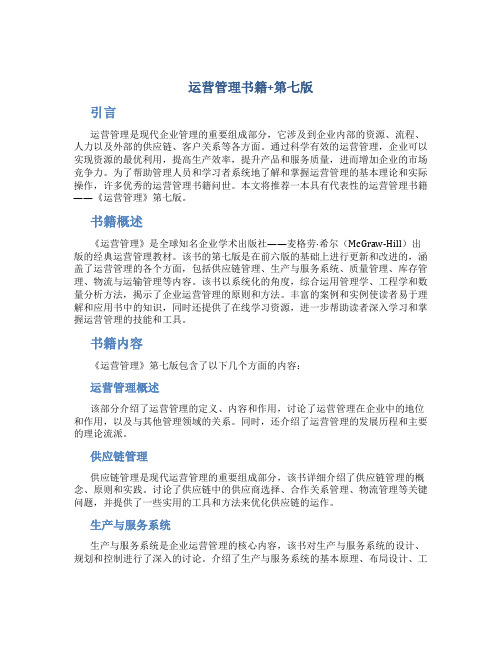
运营管理书籍+第七版引言运营管理是现代企业管理的重要组成部分,它涉及到企业内部的资源、流程、人力以及外部的供应链、客户关系等各方面。
通过科学有效的运营管理,企业可以实现资源的最优利用,提高生产效率,提升产品和服务质量,进而增加企业的市场竞争力。
为了帮助管理人员和学习者系统地了解和掌握运营管理的基本理论和实际操作,许多优秀的运营管理书籍问世。
本文将推荐一本具有代表性的运营管理书籍——《运营管理》第七版。
书籍概述《运营管理》是全球知名企业学术出版社——麦格劳·希尔(McGraw-Hill)出版的经典运营管理教材。
该书的第七版是在前六版的基础上进行更新和改进的,涵盖了运营管理的各个方面,包括供应链管理、生产与服务系统、质量管理、库存管理、物流与运输管理等内容。
该书以系统化的角度,综合运用管理学、工程学和数量分析方法,揭示了企业运营管理的原则和方法。
丰富的案例和实例使读者易于理解和应用书中的知识,同时还提供了在线学习资源,进一步帮助读者深入学习和掌握运营管理的技能和工具。
书籍内容《运营管理》第七版包含了以下几个方面的内容:运营管理概述该部分介绍了运营管理的定义、内容和作用,讨论了运营管理在企业中的地位和作用,以及与其他管理领域的关系。
同时,还介绍了运营管理的发展历程和主要的理论流派。
供应链管理供应链管理是现代运营管理的重要组成部分,该书详细介绍了供应链管理的概念、原则和实践。
讨论了供应链中的供应商选择、合作关系管理、物流管理等关键问题,并提供了一些实用的工具和方法来优化供应链的运作。
生产与服务系统生产与服务系统是企业运营管理的核心内容,该书对生产与服务系统的设计、规划和控制进行了深入的讨论。
介绍了生产与服务系统的基本原理、布局设计、工艺设计、作业调度、质量控制等方面的知识,帮助读者理解并应用生产与服务系统管理的方法。
质量管理质量管理是企业运营管理中至关重要的一个方面,该书系统地介绍了质量管理的原则、方法和工具。
运营管理15版英文版

运营管理15版英文版运营管理是一门涉及规划、组织、协调和控制组织运作的学科。
它包括了生产过程管理、供应链管理、质量管理、项目管理以及其他各种运营活动。
本文将介绍《运营管理15版英文版》的主要内容和特点。
1. 概述《运营管理15版英文版》是一本经典的运营管理教材,由作者 William J. Stevenson 编写。
该教材详细阐述了管理运营的重要性和基本原理,并通过实际案例和分析展示了运营管理在各种组织中的应用。
2. 内容•第一部分:运营管理导论–管理运营的重要性–运营管理的演变–运营管理的决策•第二部分:运营策略–竞争优势的生成–运营战略的制定–产品和服务设计•第三部分:供应链管理–供应链的角色和目标–供应链的网络设计–供应链合作与协同•第四部分:生产过程管理–生产系统设计–运作计划与控制–质量管理和成本控制•第五部分:项目管理–项目规划与组织–项目进度与资源管理–项目风险管理•第六部分:运营决策分析–数据分析方法与工具–决策树分析–模拟与决策分析技术3. 特点•综合性:该教材涵盖了运营管理领域的各个方面,从战略规划到具体实施,全面介绍了运营管理的相关内容。
•实践性:书中充满了丰富的实际案例和分析,读者可以通过这些案例深入了解运营管理在实际工作中的应用。
•知识系统性:每一章节都按照逻辑顺序展开,从基础概念到具体方法,层层推进,构建了一个完整的运营管理知识体系。
•更新性:该教材是第15版,作者对内容进行了不断更新和改进,保证了教材的前沿性和时效性。
4. 适用对象《运营管理15版英文版》适用于各类管理专业的学生以及从事运营管理工作的专业人士。
无论是学习运营管理理论知识,还是进行实际运营管理的实践,该教材都能提供有价值的帮助。
5. 结语作为一本经典的运营管理教材,《运营管理15版英文版》通过系统全面的内容和丰富的案例,帮助读者深入了解运营管理的理论和实践。
无论是在学术研究中还是在工作实践中,掌握运营管理的知识和方法都是必不可少的。
- 1、下载文档前请自行甄别文档内容的完整性,平台不提供额外的编辑、内容补充、找答案等附加服务。
- 2、"仅部分预览"的文档,不可在线预览部分如存在完整性等问题,可反馈申请退款(可完整预览的文档不适用该条件!)。
- 3、如文档侵犯您的权益,请联系客服反馈,我们会尽快为您处理(人工客服工作时间:9:00-18:30)。
Inventory
• It’s easy to value some goods, as they are readily identifiable and visible.
• However, other goods are FUNGIBLE; this would apply to most manufacturing raw materials, metals, oil and other fuels, and current asset investments.
• So the ASSUMPTIONS which undergird accounting, together with the PRINCIPLES and ENHANCING CHARACTERISTICS are fundamental topics for our studies.
Financial Accounting
Depreciation
• A business buys a new computer system for £12,000, and intends to write it off at 25% reducing balance. How much depreciation should be provided in Year 4?
Financial Accounting
• So what do these characteristics encompass?
• PREDICTIVE QUALITY • TIMELINESS • MATERIALITY • CONSERVATISM
Financial Accounting
• Understandability • Objectivity • Verifiability • Comparability • Consistency • Completeness • Substance over form • But not ACCURACY!
• Statement of Financial Position • Statement of Comprehensive Income • Statement of Changes in Equity • Statement of Cash Flows • Notes to the accounts. • It’s very much post hoc
• These ASSUMPTIONS comprise GOING CONCERN and ACCRUALS.
• What’s so special about these? And what does “accruals” mean?
• Accounting information must have RELEVANCE and must be a FAITHFUL REPRESENTATION (previously, this was termed “Reliability”).
• Depreciation is no more than a forecast. It will never be accurate. What happens where NCAs are sold for more, or less, than their book value?
Depreciation
Financial Accounting
• What is the main statement?
• It’s the STATEMENT OF FINANCIAL POSITION (see pp35-45).
• You don’t need to be able to draw up an SFP (traditionally known as a BALANCE SHEET) for FIM PGT, but you DO NEED to know the principal components of an SFP and you MUST know the ACCOUNTING EQUATION.
FINANCIAL INFORMATION MANAGEMENT
Session 2012-13 Lecture 1
Admin information
• Christopher Coles • Christopher.Coles@ • Room 469, Accounting and Finance • Textbook • Lectures • Tutorials • Exam
Depreciation
• Two main methods; STRAIGHT LINE (which is very easy) and REDUCING BALANCE (which tends to reflect reality for many items). Other methods exist.
• Reading for today; pages 20-22, 32-47, 57-71, 85, and 90-96.
Financial accounting
• This is where information on an entity’s performance is given in the form of a
Depreciation
• A business buys a lorry for £50,000. It intends to keep the lorry for four years, after which it expects the lorry’s residual value to be £10,000. How much depreciation should be provided for each year?
Valuation
• Generally, original purchase price less accumulated depreciation less any impairment.
• But what about certain assets – don’t they increase in value?
depreciate. Which one is it?
Intangibles
• Investments • Licences • Leases • Goodwill • Brands • These can depreciate (amortise) but as an
alternative, they can be subject to IMPAIRMENT REVIEW.
• The first one is Inventory. Yet few business people in the UK refer to it as that!
Inventory
• Includes raw materials, finished goods, and work in progress.
Current assets
• Items which are generally but not always smaller.
• They are almost always shown according to their liquidity, ie how easy are they to turn into cash?
often used instead if “Capital”. • Corollaries of this equation exist – they’re
on page 37. We’ll stick to A = C( or E) + L.
Components
• NON CURRENT (FIXED) ASSETS. • Tangibles and Intangibles • Tangibles include • Plant and Machinery • Vehicles • Land and buildings • Fixtures and fittings • One of the above examples doesn’t normally
How this course proceeds
• It’s fast paced and very intensive. It requires a lot of hard work.
• You need to do a lot of reading.
• Three aspects of accounting and finance; financial accounting, management accounting, financial management.
• What might be a NCA to one business might be inventory to another.
• Valuation is a manifestation of PRUDENCE. We value at the lower of original purchase price OR net realisable value.
• Depreciation is a forecast of the wearing out of an asset over time, or of its obsolescence. If we didn’t have it, our accounts wouldn’t be fair.
• IT IS NOT a source of funds for replacement of NCAs. Some commentators think depreciation is a very good thing, as it discourages ambitious It therefore helps to solve the AGENCY PROBLEM.
